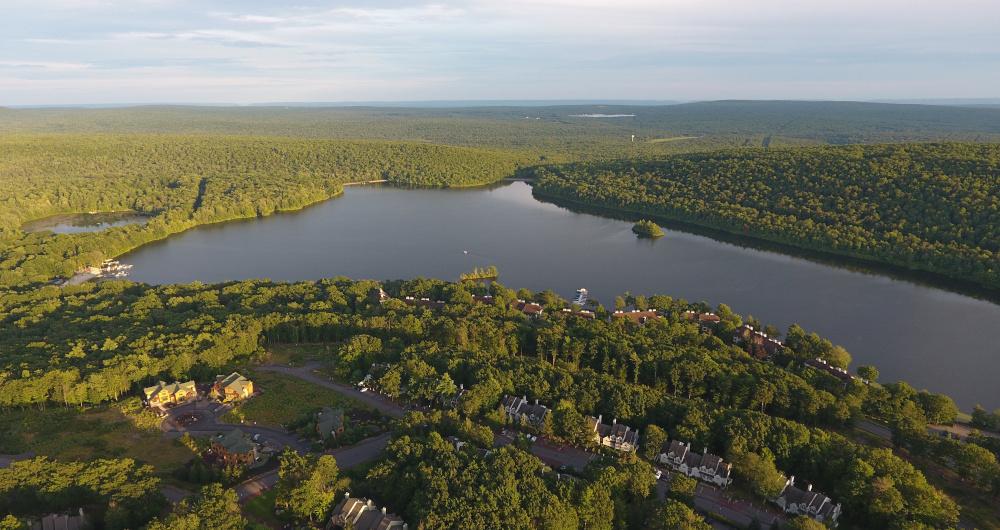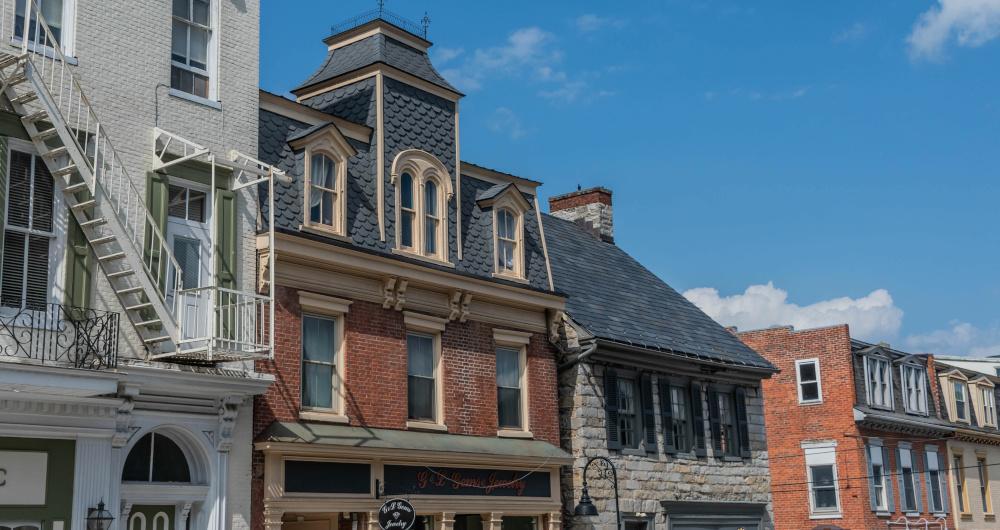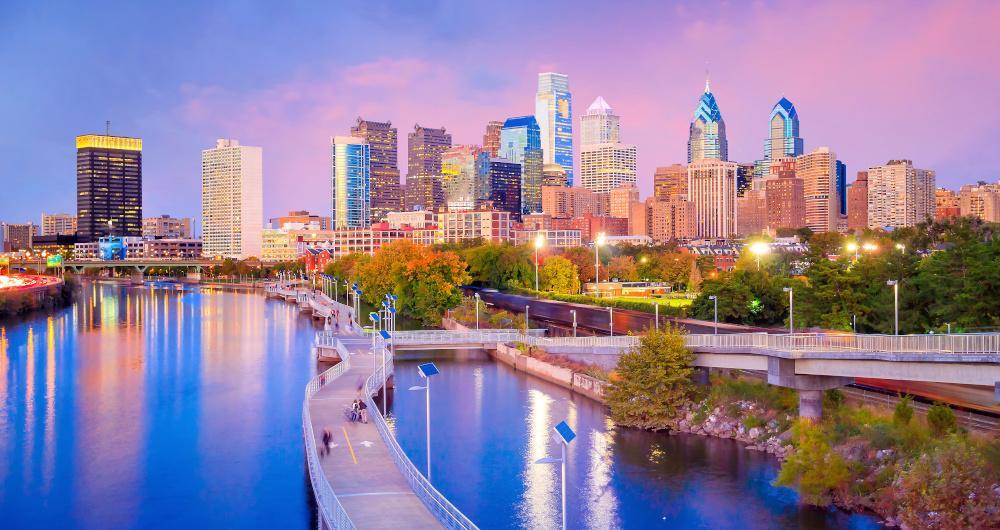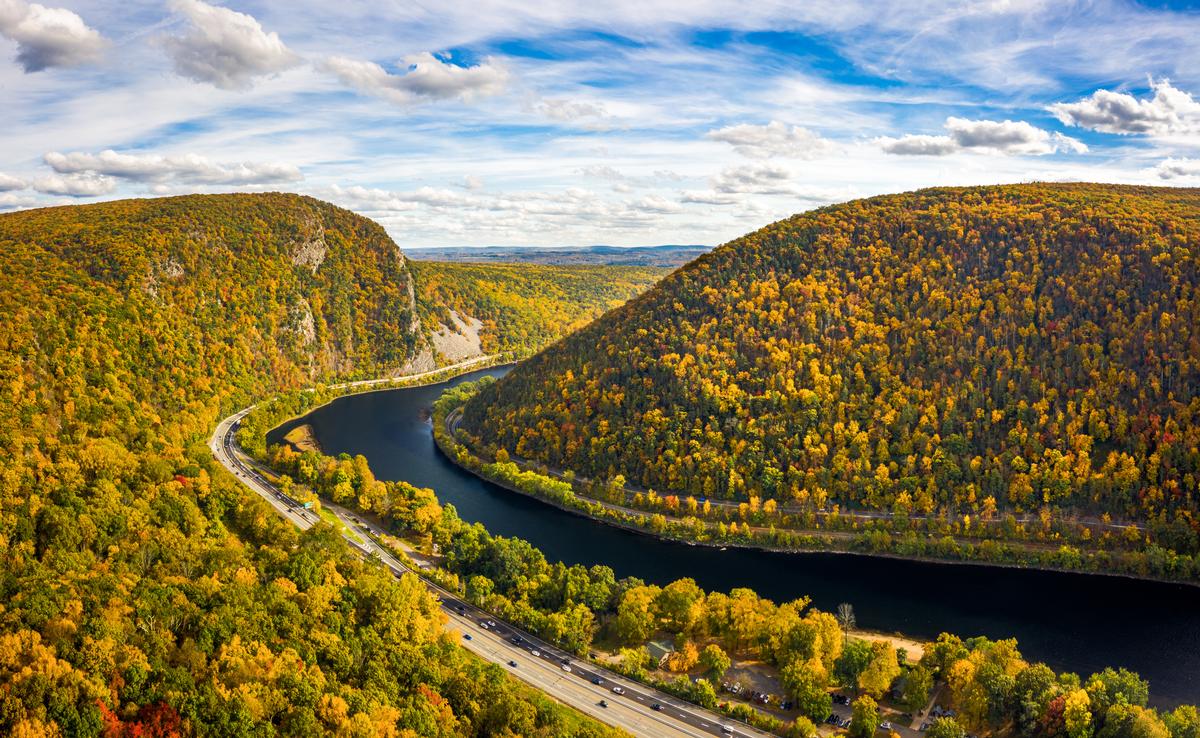Best Places to Visit in Pennsylvania

Searching for the best places to visit in Pennsylvania? Well, you are in the right place! Often overlooked in favor of New York’s glitz or the sweeping coasts of New Jersey, I think that Pennsylvania quietly hides some of the most enchanting landscapes and historic gems in the Northeast.
From rolling Appalachian ridges to quirky small towns, the Keystone State is brimming with surprises. Choosing where to go can feel overwhelming, but after winding my way across Pennsylvania on many weekend getaways and ten-day road trips while living in NYC, these are the must-visit spots I highly recommend.

1. The Poconos
I was completely taken with this mountain region and I instantly felt like I’d uncovered a spectacular hidden treasure in the Northeast! Famous for its rolling forested peaks, shimmering lakes, and hidden waterfalls, it struck me as one of those understated natural gems where every season feels like a new postcard.
When we lived in NYC for 10 years, we usually caught a Martz Trailways bus from New York Port Authority to Mount Pocono (about 2.5 hours, $40 one way).
With more than 2,400 square miles of wilderness, the region is vast but welcoming. What I especially loved was the balance between adventure and tranquility. It’s a place where I can hike through wilderness in the morning, and then unwind at a cozy lodge or spa in the evening. The sense of escape was palpable, yet it still had a welcoming, down-to-earth community feel that made it so much more than just a weekend getaway spot.
I explored the scenic Delaware Water Gap National Recreation Area, enjoyed walking on forest trails bursting with wildlife, and, when the evenings rolled in, relaxed at one of the region’s historic inns. Winter brings a completely different flavor, with skiing and snowboarding at resorts like Camelback and Jack Frost Big Boulder.
- Location: In northeastern Pennsylvania across the Pocono Mountains region, west of the Delaware Water Gap and north of the Lehigh Valley
- Location Map
What I loved best:
Watching the fall transform the mountains into a fiery tapestry of colors was my personal highlight.


2. Gettysburg
This is one of the most quietly beautiful places I’ve visited in Pennsylvania. Why do I love it here? First off, as a history buff, I've enjoyed exploring Civil War sites with my family. In addition to history, this remarkable town delivers sweeping views, peaceful trails, and a reflective atmosphere far removed from busier tourist areas.
We drove on a day trip from Harrisburg (in the past I also caught a regional bus which I thought was cheap and convenient since it only takes about 1 hour and costs around $15). I browsed Civil War relics in downtown antique shops, toured the David Wills House where Lincoln stayed before his speech, and finished the evening with a hearty Pennsylvania Dutch meal.
I didn’t expect the most moving moment to come from a model town. But when the lights dimmed at the Gettysburg Diorama, the the battle came alive with sound and shadow. The Diorama told the full story in 30 quiet minutes.
Afterward I wandered through the Gettysburg National Military Park Museum, the air thick with stillness and artifacts.
I stood where Lincoln spoke at the Soldiers' National Cemetery, the wind tugging gently at my coat.
I stayed at Hotel Gettysburg ($247) directly on Lincoln Square for two days and then found an affordable vacation rental for a week.
- Location: In south-central Pennsylvania near the Maryland border, west of York and south of Harrisburg
- Location Map
What I loved best:
Exploring Lincoln Square, where history lingered behind every storefront window, was my favorite highlight.

3. Lancaster
I was instantly charmed by this city that beautifully balances its rich heritage with a refreshing outdoorsy vibe. Known for its historic character and lush surroundings, the "Red Rose City" is a place where cobblestone streets, Georgian and Victorian architecture, and green open spaces all blend together seamlessly.
Instead of driving, I caught an Amtrak Keystone Service train from Philadelphia (about 1 hour 15 minutes, $20). I based myself at Lancaster Marriott at Penn Square for a few days.
What really stood out to me was how walkable and welcoming it felt. There’s a warm community atmosphere here, and the city offers the perfect mix of cultural depth and access to nature. It felt like one of those understated gems where every corner has a story, yet you’re never far from wide, unspoiled countryside.
I filled my time happily with strolls along the scenic Lancaster Canal, browsing the quirky shops and cafés in the city centre, and taking in the vibrant local markets. I admired the collections at the City Museum, and soaked in the atmosphere around Dalton Square.
For a dose of nature, I wandered through Williamson Park, with its leafy trails and the magnificent Ashton Memorial, before heading further afield to enjoy the rolling hills of the nearby Forest of Bowland. Lancaster, to me, was the perfect combination of history, charm, and natural beauty.
- Location: In south-central Pennsylvania in the heart of Amish Country, west of Reading and east of York
- Location Map
What I loved best:
Exploring the impressive Lancaster Castle was a standout.


4. Jim Thorpe
Tucked into the Pocono Mountains like a hidden valley of its own, this is one of the most captivating historic towns I’ve ever visited in Pennsylvania, and I think it’s one of the absolute best destinations near the Poconos. Why? I fell for winding mountain roads, dramatic river views, and a downtown that feels untouched by time. I drove 1 hour 40 minutes northwest from Philadelphia into this town (population about 4,600), often called the “Switzerland of America” for its steep hillsides and Victorian architecture that completely won me over.
My afternoon included a stroll through Broadway lined with historic buildings, a ride on the Lehigh Gorge Scenic Railway, and a hike along the Switchback Trail overlooking the town. The Asa Packer Mansion tour gave me a taste of the town’s rich railroad history.
- Location: In northeastern Pennsylvania in the Pocono Mountains, south of Lake Harmony and north of Lehighton
- Location Map
What I loved best:
The way the local brewery scene made evenings lively and relaxed.

5. Bedford, PA
I thought this was such a unique and picturesque spot and it quickly became one of my favorite weekend getaways from Pittsburgh! With its historic architecture, brick streets, and mountain views, the town’s welcoming charm made me feel as though I’d wandered into another era.
We drove 2 hours east from Pittsburgh into Bedford (population about 2,800), a historic town nestled in the Allegheny Mountains.
I stayed at the Omni Bedford Springs Resort, a landmark dating back to the 18th century, where U.S. presidents once vacationed. Over two days, I explored the Fort Bedford Museum, strolled past colonial-era taverns and stone churches, browsed antique shops along the brick-lined streets, and wandered through Bedford’s tree-lined neighborhoods with views of rolling hills.
- Location: In south-central Pennsylvania in the Allegheny Mountains, west of Everett and east of Somerset
- Location Map
What I loved best:
Hiking in Shawnee State Park was my personal highlight because it offered peaceful lakeside trails and scenic mountain overlooks.
On my second visit, winter added another layer of charm with quiet snowy streets, holiday lights, and downhill skiing not far away at Blue Knob Resort.

6. Easton, Pennsylvania
Ready for a riverside getaway? Check out Easton—a real gem of the Lehigh Valley! I found this spot to be an easy romantic day trip from Philadelphia, about one hour and 30 minutes by car.
We started exploring along the 1.75-mile Karl Stirner Arts Trail. Easton blended art and nature with a kind of quiet confidence
The trail itself was flat and stroller-friendly, tracing the Bushkill Creek.
Afterward, we stopped at Easton Public Market for lunch. My son had a grilled cheese and I had a bowl of butternut squash soup that smelled of rosemary and warmth. We ended with pastries from a corner stall and sat along the river.
- Location: In eastern Pennsylvania at the confluence of the Delaware and Lehigh Rivers, east of Allentown and west of Phillipsburg, New Jersey
- Location Map
What I loved best:
Walking along the riverside trail was the perfect way to stay active while discovering a new place, my favorite highlight.

7. Philadelphia, PA
I thought this city was a brilliant choice for a family-friendly city escape, definitely one of the best places to Visit in Pennsylvania!
I took an Amtrak Northeast Regional train from Washington, D.C. (about 1 hour 45 minutes, $40). The setting was both historic and dynamic with cobblestone streets and colonial landmarks set against modern skyscrapers, leafy squares, and a vibrant waterfront. I especially loved how the city’s welcoming, down-to-earth feel blended seamlessly with its adventurous food and cultural spirit.
Philly shines in its cultural and recreational mix: from the Liberty Bell and Independence Hall to sprawling Fairmount Park and family-oriented museums like the Franklin Institute.
On my first day, Awbury Arboretum felt like discovering a hidden sanctuary right within the city, tucked into Germantown, it’s 55 acres of meadows, woodlands, and historic landscapes that feel worlds away from Philadelphia’s busy streets. Free and open to the public every day, Awbury offers a rare mix of history, nature, and community, the kind of place where you can wander for hours and always stumble on something new.
Independence Seaport Museum was our afternoon stop where my son's favorite thing to do was visiting the cruiser USS Olympia (the world’s oldest floating steel warship!).
That evening, I found Bob & Barbara’s to be the perfect late-night spot where we stopped after dinner, grabbed a Citywide Special ($5), and settled into the sounds of Hammond B3 organ-driven jazz.
A great way to get to know the city through a local's lens is by taking an Armond Scavo Photography Tour of Philadelphia.
From my base near Rittenhouse Square, I explored on foot and by bike, stopping at Reading Terminal Market for foodie finds, gliding along the Schuylkill River Trail, and diving into hands-on science exhibits.
Locals told me the city has something in every season: cherry blossoms and baseball in spring, lively festivals in summer, colorful foliage in autumn, and twinkling holiday markets and light shows in winter.
- Location: In southeastern Pennsylvania along the Delaware River, north of Wilmington, Delaware, and south of Trenton, New Jersey
- Location Map
What I loved best:
One of the area’s most enchanting discoveries for me was the Wharton Esherick Museum, tucked into the wooded hills just a 25-minute SEPTA train ride from Philly. The museum—once the home and studio of the visionary wood sculptor—is like stepping into a living piece of art. Wandering through those warm, wooden spaces, surrounded by Esherick’s whimsical, organic designs, left me feeling inspired and grounded at the same time. It’s the kind of place that reveals Paoli’s creative undercurrent, hidden just beneath its suburban surface.



8. Doylestown, PA
Ready for a history-rich, creativity-filled escape? Doylestown is a real standout! I found this gem nestled in the heart of Bucks County, surrounded by rolling farmland and only about 8,500 residents.
We caught the SEPTA Lansdale/Doylestown regional rail line from Philadelphia (about 1 hour 15 minutes, $7).
Despite its size, it’s rich in culture, home to unique landmarks like the Mercer Museum, Fonthill Castle, and the James A. Michener Art Museum, all built from quirky hand-poured concrete that gives the town its distinctive character.
If your schedule is flexible, visit in the spring when the gardens and countryside bloom.
- Location: In southeastern Pennsylvania in Bucks County, north of Philadelphia and south of Quakertown
- Location Map
What I loved best:
Visiting in the fall to admire fall foliage was my favorite highlight.



9. Pittsburgh
I thought this city was such a dynamic and picturesque city, and I think it’s one of the best city escapes in the region! With its historic steel bridges, red-brick neighborhoods, and the three rivers winding through dramatic hillsides, the city’s energy and warmth made it one of the most unexpectedly gorgeous urban landscapes I’ve ever experienced.
I discovered it in western Pennsylvania, where the Allegheny, Monongahela, and Ohio Rivers converge, giving Pittsburgh its iconic nickname “The City of Bridges” (there are over 400!). Once famous as the steel capital of the world, it has reinvented itself as a hub of innovation, medicine, and culture, al while preserving its storied past..
After a 5-hour drive from Washington, D.C., I stayed for four days at SpringHill Suites by Marriott Pittsburgh Mt. Lebanon and enjoyed great breakfast pancakes at Dor-Stop Restaurant just 6 minutes by car. I toured the fascinating Phipps Conservatory and Botanical Gardens, rode the historic Duquesne Incline for breathtaking skyline views, wandered around the Strip District’s quirky markets and restaurants, and admired masterpieces at the Carnegie Museum of Art.
Stopping at Bicycle Heaven (the world’s largest bicycle museum and bike shop in the world!) is a must for any bike lover. Containing over 4,000 vintage and collectible bikes, this place has unique themed bikes, such as bikes representing The Beatles, Elvis, and bobbleheads, and there are bikes that were used in movies such as A Beautiful Mind and Pee-wee’s Big Adventure.
In addition, I loved exploring the habitats at the National Aviary ($20.95 general admission), especially the tropical rainforest habitat, and the wetlands.
- Location: In western Pennsylvania at the confluence of the Allegheny and Monongahela Rivers, forming the Ohio River; southeast of Beaver and north of Washington
- Location Map
What I loved best:
We returned in winter and loved the cozy atmosphere of holiday lights at PPG Place, ice skating downtown, catching a Penguins hockey game, and warming up with hearty meals in the city’s many gastropubs and breweries.



10. Hershey
This town, set among rolling farmland in central Pennsylvania, is one of my favorite places to visit when I want a blend of fun, history, and outdoor adventure (and lots of chocolate!). My husband, son and I drove 20 minutes east from Harrisburg into this small town built on chocolate. This was a sweet escape in every sense of the word! Hershey, often called “The Sweetest Place on Earth,” charmed me with its mix of small-town warmth, chocolate-themed attractions, and surprisingly upscale touches.
My afternoon included a visit to Hershey’s Chocolate World for a factory tour and sweet samples, a ride on the roller coasters at Hersheypark, and a quiet stroll through Hershey Gardens with its colorful butterfly atrium.
I really enjoyed my stay in this iconic destination, where rolling Pennsylvania hills, lush countryside, and tree-lined streets created a welcoming and picturesque backdrop. It struck the perfect balance of family-friendly fun and refined leisure.
Instead of alpine slopes, I dove into chocolate-infused adventures at Hershey’s Chocolate World, twirled through the rides at Hersheypark, and admired rare exotic blooms at the Hershey Gardens. I also treated myself at The Spa at The Hotel Hershey, famous for its cocoa-based treatments like a whipped cocoa bath and chocolate fondue wrap!
My best food moment: I had a sweet breakfast at The Circular at Hotel Hershey. I ordered lemon-ricotta pancakes with blueberry compote and mascarpone cream. We ate under a stained-glass dome with garden views. The meal was decadent and truly memorable.
- Location: In south-central Pennsylvania east of Harrisburg, west of Lebanon, and near the Swatara Creek
- Location Map
What I loved best:
For me, Hershey is one of the best places to visit in Pennsylvania because it's exciting, unique, and hope you will love it too!
Making my own chocolate bar at Hershey’s Chocolate World (we were smiling like kids again!) was my favorite highlight.





Booking Checklist
1. Book Your Flight - I use Expedia because I like their mobile app with my itinerary. They've helped me re-book flights on many occasions. Once you reach their Gold tier, support is especially good.
2. Book Your Hotel - I use Booking.com or Expedia, depending on my destination.
3. Book Your Rental Car - I use Expedia.
4. Book your tours on Viator or Get Your Guide.
5. If you are planning to visit more than three national parks in the next 12 months, buy the America the Beautiful Pass.
